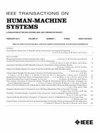全触控人机界面模式会给驾驶员的横向控制能力带来哪些挑战?基于真实道路的比较研究
IF 3.5
3区 计算机科学
Q2 COMPUTER SCIENCE, ARTIFICIAL INTELLIGENCE
引用次数: 0
摘要
近年来,全触控人机界面(HMI)模式在特斯拉制造的汽车上得到了广泛应用。这种交互模式用屏幕取代了传统的物理交互方式,具有良好的科技体验感。然而,这种模式是否会使驾驶员的横向控制比传统模式(CM)更具挑战性,目前尚不清楚。为了研究这个问题,我们设计了两个最常见的辅助任务:拨号和导航输入任务,并使用两辆装有仪器的车辆进行了实际道路实验。分别在不同模式下收集了车辆运行参数和驾驶员手动数据。有趣的是,在不同次要任务中,全触控模式(FTM)对驾驶员横向控制能力的影响出现了相反的结果。与 CM 相比,全触控模式下驾驶员在拨号任务中的横向控制能力相对于基线驾驶下降较少,而全触控模式下驾驶员在导航输入任务中的横向控制能力下降较多。此外,无论驾驶模式如何,随着任务难度和驾驶速度的增加,驾驶员的横向控制能力都会进一步下降。本研究为全触控人机界面模式相关法律法规的制定提供了理论依据。本文章由计算机程序翻译,如有差异,请以英文原文为准。
What Challenges Does the Full-Touch HMI Mode Bring to Driver's Lateral Control Ability? A Comparative Study Based on Real Roads
In recent years, the full-touch human–machine interface (HMI) mode has been widely used in vehicles built by Tesla. This interaction mode replaces the conventional physical interaction modality with a screen, and it has a good sense of technological experience. However, it is unclear whether this mode will make the driver's lateral control more challenging than the conventional mode (CM). To investigate this issue, two most common secondary tasks were designed: dialing and navigation entry tasks and real-world road experiments were conducted using two instrumented vehicles. The vehicle operating parameters and the driver manual data were collected in different modes, respectively. Interestingly, the opposite results were found regarding the effect of the full-touch mode (FTM) on the driver's lateral control ability in different secondary tasks. Compared with the CM, the lateral control ability decreased less during the dialing task relative to the baseline driving in the FTM, while the lateral control ability decreased more in the FTM during the navigation entry task. In addition, drivers’ lateral control decreased further as task difficulty and driving speed increased regardless of mode. This study provides a theoretical basis for the development of laws and regulations regarding full-touch HMI mode.
求助全文
通过发布文献求助,成功后即可免费获取论文全文。
去求助
来源期刊

IEEE Transactions on Human-Machine Systems
COMPUTER SCIENCE, ARTIFICIAL INTELLIGENCE-COMPUTER SCIENCE, CYBERNETICS
CiteScore
7.10
自引率
11.10%
发文量
136
期刊介绍:
The scope of the IEEE Transactions on Human-Machine Systems includes the fields of human machine systems. It covers human systems and human organizational interactions including cognitive ergonomics, system test and evaluation, and human information processing concerns in systems and organizations.
 求助内容:
求助内容: 应助结果提醒方式:
应助结果提醒方式:


